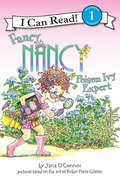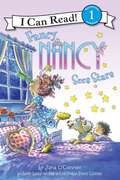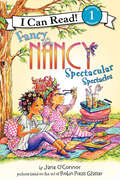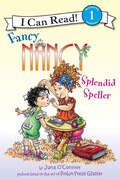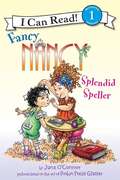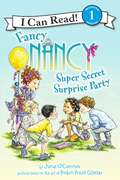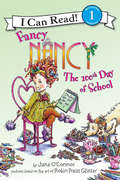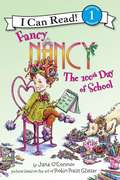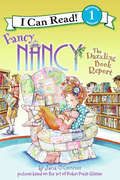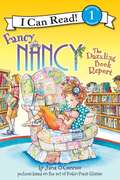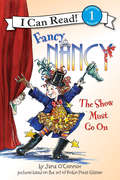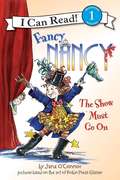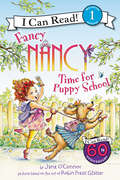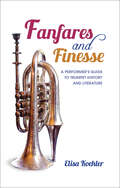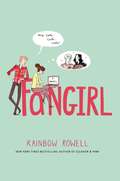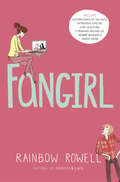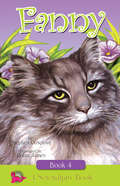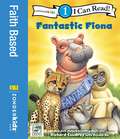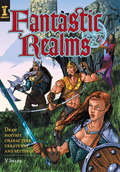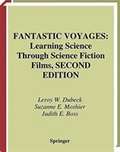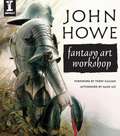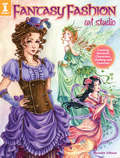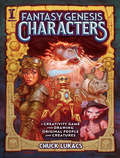- Table View
- List View
Fancy Nancy: Poison Ivy Expert (I Can Read Level 1)
by Jane O'ConnorNancy realizes that even experts can always learn something new in this hilarious Fancy Nancy story from the beloved New York Times bestselling author-illustrator team Jane O’Connor and Robin Preiss Glasser. When Nancy picks flowers for Ms. Glass's surprise party, she is overjoyed—until she discovers an unpleasant surprise of her own! How could Nancy, practically a poison ivy expert, come down with something so unfancy?Fancy Nancy: Poison Ivy Expert is a Level One I Can Read book, which means it's perfect for children learning to sound out words and sentences. The back matter features a list of the rich vocabulary words that are used throughout the story along with their definition.
Fancy Nancy: Sees Stars (I Can Read! #Level 1)
by Jane O'ConnorNancy absolutely adores stars. She loves how they sparkle in the sky, and she can even name the constellations. Nancy can hardly wait for her class visit to the planetarium! Young readers will delight in this newest addition to the Fancy Nancy I Can Read series, sharing in Nancy's anticipation and disappointment when the trip doesn't go as planned. But with her trademark panache, Nancy manages to make even this frustrating situation fun-and, of course, fancy. Picture descriptions present.
Fancy Nancy: Spectacular Spectacles (I Can Read Level 1)
by Jane O'ConnorThis addition to the Fancy Nancy I Can Read series from New York Times bestselling team Jane O’Connor and Robin Preiss Glasser is sure to delight young readers everywhere!Nancy thinks that Bree's new glasses are simply spectacular. After all, they are lavender. They are glittery. And best of all, they come in a silver case. So when Bree tells Nancy all about her trip to the eye doctor, Nancy can't help but wonder if her own eyesight is perhaps getting a little blurry too. . . .Fancy Nancy: Spectacular Spetacles is a Level One I Can Read book, which means it's perfect for children learning to sound out words and sentences. The back matter features a list of the rich vocabulary words that are used throughout the story along with their definition.
Fancy Nancy: Splendid Speller (I Can Read Level 1)
by Jane O'ConnorYoung readers will relate to Nancy's test-taking dilemma in this Fancy Nancy I Can Read story from the New York Times bestselling team Jane O’Connor and Robin Preiss Glasser.Nancy loves spelling. She can spell fun words like "happy" and French words like chien (that means "dog") and even long words like "splendid." But when Ms. Glass's spelling test is harder than Nancy anticipated, the self-professed spelling prodigy faces a tough decision that pits her pride against her principles.Fancy Nancy: Splendid Speller is a Level One I Can Read book, which means it's perfect for children learning to sound out words and sentences. The back matter features a list of the rich vocabulary words that are used throughout the story along with their definition. Whether shared at home or in a classroom, the short sentences, familiar words, and simple concepts of Level One books support success for children eager to start reading on their own.
Fancy Nancy: Splendid Speller (I Can Read! #Level 1)
by Jane O'ConnorWhere spelling is concerned, Nancy is better than great--she's splendid! But when Ms. Glass's spelling test is harder than Nancy anticipated, the self-professed spelling prodigy faces a tough decision.
Fancy Nancy: Super Secret Surprise Party (I Can Read Level 1)
by Jane O'ConnorJoin Fancy Nancy as she plans a surprise party in New York Times bestselling team Jane O'Connor and Robin Preiss Glasser's beginning reader Fancy Nancy: Super Secret Surprise Party.Shh! Fancy Nancy and her classmates are planning a surprise party—that means it's top secret! Together Nancy and her friends prepare the treats and decorate the classroom for the party. Everything has to be kept super secret. Even the cupcakes have a surprise inside! Will you be able to guess who the party is for? Fans of Fancy Nancy will delight as they join Nancy in planning a fabulous surprise.This Level One I Can Read book is perfect for children learning to sound out words and sentences.
Fancy Nancy: The 100th Day of School (I Can Read Level 1)
by Jane O'ConnorCelebrate the 100th day of school with Fancy Nancy, in this sweet and thoughtful I Can Read Story from New York Times bestselling team Jane O’Connor and Robin Preiss Glasser. Perfect for back-to-school! With the 100th day of school just around the corner, Nancy finds herself utterly stumped. She can’t think of anything exciting, special, or imaginative enough to bring in to class to commemorate the day. Just as Nancy begins to lose hope, she finds inspiration from an unexpected source—and learns that even sad events can bring with them a glimmer of beauty.Fancy Nancy: The 100th Day of School is a Level One I Can Read book, which means it's perfect for children learning to sound out words and sentences. The back matter features a list of the rich vocabulary words that are used throughout the story along with their definition.
Fancy Nancy: The 100th Day of School (I Can Read! #Level 1)
by Jane O'ConnorWith the 100th day of school just around the corner, Nancy finds herself utterly stumped. She can't think of anything exciting, special, or imaginative enough to bring in to class to commemorate the day. Just as Nancy begins to lose hope, she finds inspiration from an unexpected source--and learns that even sad events can bring with them a glimmer of beauty.
Fancy Nancy: The Dazzling Book Report (I Can Read Level 1)
by Jane O'ConnorJoin Nancy as she learns that you can't judge a book report by its cover! With simple text and vibrant illustrations, this Fancy Nancy I Can Read story from the beloved New York Times bestselling author-illustrator team Jane O’Connor and Robin Preiss Glasser will delight readers young and old.Nancy's first book report is sure to be dazzling. After all, she is the second-best artist in her class. She is using beads, fringe, and a fancy border. And she is writing about Sacajawea, a true-life heroine. What could go wrong?Fancy Nancy: The Dazzling Book Report is a Level One I Can Read book, which means it's perfect for children learning to sound out words and sentences. The back matter features a list of the rich vocabulary words that are used throughout the story along with their definition.
Fancy Nancy: The Dazzling Book Report (I Can Read! #Level 1)
by Jane O'Connor<P>Nancy is determined to make the cover of her very first book report as fancy as she can, but she spends so much time on it that she has no time to write about the book.
Fancy Nancy: The Show Must Go On (I Can Read Level 1)
by Jane O'ConnorNancy brings her trademark panache to the school talent show!
Fancy Nancy: The Show Must Go On (I Can Read! #Level 1)
by Jane O'Connor<P> Nancy has her act for the school's talent show all planned out: She and Bree will do an absolutely stupendous song-and-dance number together. But when Ms. Glass assigns partners for the show, Nancy gets paired up with Lionel. He's the shyest boy in class! Will Nancy and Lionel be able to work together to perform one marvelous act? Or will the show go on without them? <P>The simple text and vivid illustrations in this newest Fancy Nancy I Can Read are sure to have readers everywhere crying, "Encore!"
Fancy Nancy: Time for Puppy School (I Can Read Level 1)
by Jane O'ConnorOoh la la—school starts soon! Fancy Nancy can’t wait to go back, but she’ll miss Frenchy very much. Nancy’s loved playing with her favorite puppy all summer, but sometimes Frenchy can be a bit naughty. When she gets into trouble one too many times, the Clancys decide that it’s time for Frenchy to go to school, too—puppy school! But will Frenchy change her doggy ways?Beginning readers will love joining Nancy and Frenchy as they get ready for school in this Fancy Nancy I Can Read. Time for Puppy School is the newest work from New York Times bestselling team Jane O’Connor and Robin Preiss Glasser.Time for Puppy School is a Level One I Can Read book, which means it’s perfect for children learning to sound out words and sentences.
Fanfares and Finesse: A Performer's Guide To Trumpet History And Literature
by Elisa KoehlerUnlike the violin, which has flourished largely unchanged for close to four centuries, the trumpet has endured numerous changes in design and social status from the battlefield to the bandstand and ultimately to the concert hall. This colorful past is reflected in the arsenal of instruments a classical trumpeter employs during a performance, sometimes using no fewer than five in different keys and configurations to accurately reproduce music from the past. With the rise in historically inspired performances comes the necessity for trumpeters to know more about their instrument's heritage, its repertoire, and different performance practices for old music on new and period-specific instruments. More than just a history of the trumpet, this essential reference book is a comprehensive guide for musicians who bring that musical history to life.
Fangirl
by Rainbow RowellIn Rainbow Rowell's Fangirl, Cath is a Simon Snow fan. Okay, the whole world is a Simon Snow fan, but for Cath, being a fan is her life--and she's really good at it. She and her twin sister, Wren, ensconced themselves in the Simon Snow series when they were just kids; it's what got them through their mother leaving. Reading. Rereading. Hanging out in Simon Snow forums, writing Simon Snow fan fiction, dressing up like the characters for every movie premiere. Cath's sister has mostly grown away from fandom, but Cath can't let go. She doesn't want to. Now that they're going to college, Wren has told Cath she doesn't want to be roommates. Cath is on her own, completely outside of her comfort zone. She's got a surly roommate with a charming, always-around boyfriend, a fiction-writing professor who thinks fan fiction is the end of the civilized world, a handsome classmate who only wants to talk about words . . . And she can't stop worrying about her dad, who's loving and fragile and has never really been alone. For Cath, the question is: Can she do this? Can she make it without Wren holding her hand? Is she ready to start living her own life? Writing her own stories? And does she even want to move on if it means leaving Simon Snow behind?
Fangirl
by Rainbow RowellIn Rainbow Rowell's Fangirl, Cath is a Simon Snow fan. Okay, the whole world is a Simon Snow fan, but for Cath, being a fan is her life-and she's really good at it. She and her twin sister, Wren, ensconced themselves in the Simon Snow series when they were just kids; it's what got them through their mother leaving. Reading. Rereading. Hanging out in Simon Snow forums, writing Simon Snow fan fiction, dressing up like the characters for every movie premiere. Cath's sister has mostly grown away from fandom, but Cath can't let go. She doesn't want to. Now that they're going to college, Wren has told Cath she doesn't want to be roommates. Cath is on her own, completely outside of her comfort zone. She's got a surly roommate with a charming, always-around boyfriend, a fiction-writing professor who thinks fan fiction is the end of the civilized world, a handsome classmate who only wants to talk about words . . . <P>And she can't stop worrying about her dad, who's loving and fragile and has never really been alone. For Cath, the question is: Can she do this? Can she make it without Wren holding her hand? Is she ready to start living her own life? And does she even want to move on if it means leaving Simon Snow behind? <br><b> A New York Times Best Seller!</b>
Fangirl
by Rainbow RowellLa deliciosa y emotiva historia de una nerd destinada a la grandeza... Cath y Wren son gemelas idénticas, y hasta hace poco lo hacían absolutamente todo juntas. Ahora están a la universidad. Wren le ha dejado claro que no piensa compartir habitación con ella. Para Wren es una oportunidad única de empezar de cero y conocer gente. Para Cath no es tan fácil. Es terriblemente tímida. Su único mundo es ser fan de Simon Snow, donde ella se siente a gusto, donde siempre sabe exactamente qué decir y donde puede escribir un romance mucho más intenso que cualquier cosa que haya experimentado en la vida real. Sin Wren, Cath se siente completamente sola, fuera de su zona de confort. Tiene una compañera de cuarto antipática, siempre acompañada de su atractivo novio, un profesor de escritura que piensa que el fan fiction es el fin del mundo civilizado, un guapo compañero de clase, que sólo quiere hablar de palabras...Y además no puede dejar de preocuparse por su padre, que es amoroso y frágil y nunca ha estado realmente solo. Ahora Cath tiene que decidir si está dispuesta a abrir su corazón a los nuevos amigos y a las nuevas experiencias, y se está dando cuenta de que hay mucho más que aprender sobre el amor de lo que nunca creyó posible. Reseñas: «Conmovedora. Absolutamente real.»Publisher's Weekly «Absolutamente cautivadora.»Kirkus Reviews «Los diálogos realmente auténticos, una notable empatía con los adolescentes, un retrato honesto de los jóvenes y el primer amor ofrecen una lectura fascinante.»Lancashire Evening Post «Una novela divertida, triste, inteligente y entretenida.»Armadillo Magazine «Una delicia para los adolescentes en la búsqueda del primer amor... lo suficientemente inteligente como para mantenerles leyendo.»The Daily Telegraph
Fanny
by Stephen Cosgrove Robin JamesFanny, the cat, has only three legs on which she manages just fine. She is normal as normal can be. Sadly, the other animals on the Serendipity Farm won't befriend her because they are afraid she will feel uncomfortable since after all she has but three legs. A little dog named Ruby learns that handicap is just a state of mind. Ages 5-9.
Fanny Crosby's Life-Story By Herself
by Fanny CrosbyFanny Crosby’s Life-Story by Herself is an inspiring autobiography of one of the most prolific hymn writers in history. Blind from infancy, Fanny Crosby overcame significant challenges to become a celebrated poet, lyricist, and advocate for the visually impaired. In her own words, Crosby reflects on her remarkable life, filled with unwavering faith, resilience, and an extraordinary gift for composing hymns that continue to inspire generations.The narrative begins with Crosby’s childhood in rural New York, where she describes the early loss of her sight and the influence of her grandmother, who nurtured her education and faith. Rather than focusing on limitations, Crosby embraces her condition as a divine calling, crediting her blindness with sharpening her spiritual vision. Her journey takes readers through her time at the New York Institution for the Blind, where she developed her love for music, writing, and teaching.Crosby shares heartfelt stories of the people, places, and experiences that shaped her—particularly her encounters with influential figures, including U.S. presidents and prominent religious leaders. Central to the autobiography is her deep Christian faith, which not only inspired her personal life but also fueled the creation of over 8,000 hymns, including beloved classics like “Blessed Assurance” and “To God Be the Glory.”Beyond her musical achievements, Crosby’s work as a public speaker and social reformer shines through, revealing her commitment to serving others, especially the poor and disabled. Her humility, humor, and sense of purpose resonate throughout the book, offering readers a glimpse into the heart of a woman whose words touched countless lives.Fanny Crosby’s Life-Story by Herself is not only a testament to personal triumph but also an invitation to trust in the power of faith and perseverance. For readers drawn to memoirs, hymnody, or stories of spiritual inspiration, this autobiography remains a deeply moving and timeless account of a life well lived in service to God and humanity.
Fantastic Fiona: Level 1 (I Can Read! / A Fiona the Hippo Book)
by ZondervanJoin your favorite hippo, Fiona, the adorable internet sensation from the Cincinnati Zoo and Botanical Garden, as she visits her zoo friends, finding out what makes each one special. Is it their speedy running? Their lovely singing? And what makes Fiona so special to all of her friends?Young readers will enjoy learning more about Fiona and her friends in this Level One I Can Read about the little hippo that has captured hearts around the world with her inspiring story and plucky personality.Fantastic Fiona is:An endearing animal book that&’s a perfect gift from parents and grandparentsAn inspiring story about what makes each of us unique and specialA Level One I Can Read story geared for children just learning to readCreated by New York Times bestselling artist Richard Cowdrey of Fiona the Hippo; A Very Fiona Christmas; Fiona, It&’s Bedtime; Legend of the Candy Cane; Bad Dog, Marley; and A Very Marley Christmas fame
Fantastic Realms!: Draw Fantasy Characters, Creatures and Settings
by V. Shane ColcloughCreate Your Own Fantastic Realms!An arduous journey leads you to a hilltop. Before you stretches a land of castles filled with noble knights, elven warriors and fearsome goblins and gargoyles. At your feet lies a book...Within its pages you will discover the secrets to sketching, drawing and coloring wondrous worlds - realms filled with creatures friendly and foul, beautiful princesses and stealthy magic-users, ancient ruins and dragons' lairs.Begin your journey by following the steps within, which will guide you from simple sketches to fully colored works of art. Take heart, brave traveler, for you'll be aided in your quest by:Texture and coloring keys that show you exactly how to create dozens of different effectsA brainstorming game that, with a roll of the dice, allows you to mix and match character, creature and scene characteristicsBut beware, friend: Along the way, you will be powerless to resist the temptation to explore the strange and twisted detours of your own utterly original imaginings. Wield your pencil bravely - so begins your adventure...30+ step-by-step demonstrations make it easy to create your own fantastic worlds!The Characters: Human or elf, fighter or princess ... learn to outfit your characters with specialized clothing, weaponry and magical items, and tell their tales with dynamic gesture and motion.The Creatures: Evoke dragons, demons, griffins and other edgy beasts of your own twisted imaginings, with special attention to key details that make them look regal or demented.The Settings: Construct convincing environments that set the tone and atmosphere of your story, be it a mysterious tower, ancient ruins or a peaceful village.
Fantastic Voyages: Learning Science Through Science Fiction Films
by Leroy W. Dubeck Suzanne E. Moshier Judith E. BossBy revealing the facts behind the fiction of some of the finest films in the sci-fi genre, "Fantastic Voyages" offers a novel approach to teaching science: using scenes from science fiction films to illustrate fundamental concepts of physics, astronomy, and biology.
Fantasy Art Workshop
by John HoweHere's how I do it, and why?: this is the premise behind John Howe's very first practical exploration of his artistic inspirations, approaches and techniques. Perfect for practical artists and fans of John Howe's work, this book provides step-by- step demonstrations, sketches and outstanding finished paintings, some of which were designed specifically for this book. The book covers a wide range of subjects essential to any aspiring fantasy artist, including materials and the creative process, as well as drawing and painting humans, beasts, landscapes and architecture. Readers will also find further inspiration and guidance on presenting work in various forms including film work, book covers and advertising.
Fantasy Fashion Art Studio: Creating Romantic Characters, Clothing and Costumes
by Meredith DillmanLive out all your fashion fantasies! Flower fairies, water spirits, enchanted forests, Victorian ladies and more! Immerse yourself in timeless stories inspired by nature, myths, legends and literature! With Fantasy Fashion Art Studio, you'll learn the basics for sketching and watercolor painting; you'll also learn to draw and paint beautiful, ethereal characters! Inside you'll explore: Lessons and tips for sketching characters--proportions, heads, hands, feet, hair, wings and more. Drawing and painting tips for fashions from the medieval, Renaissance and Victorian periods as well as traditional Japanese, Steampunk, folk and gothic influences. 10 fully stepped-out demonstrations for drawing and painting a multitude of dreamy characters, including mermaids, enchanted princesses, fairies and more. 18 mini step-by-step demonstrations to help you create dreamscape scenes, including the night skies, forests, architecture, flowers and leaves. A fashionable trip through a fantasy landscape, Fantasy Fashion Art Studio will help you bring all of your fantasies to life!
Fantasy Genesis Characters: A creativity game for drawing original people and creatures
by Chuck LukacsConjure creatures and characters from your imagination! To generate fantasy characters and inhabitants that populate an imaginary world, sometimes you need a little creative fuel...and a 20-sided die.Fantasy Genesis Characters is a choose-your-own-adventure game where a roll of the dice decides what type of creature you create. Each chapter expands on mimicking the observable world to engineer original populations by mashing up unrelated quirks and concepts--think "vegetarian zombie," "Byzantine goth" or "gangster sheep." Roll the dice to combine traits from word lists. Mix random emotions, behaviors, costumes, cultures and anthropomorphic attributes to create infinite and unexpected characters. Short lessons supply the building blocks to develop character components--expressions, gestures, posture, etc.--while mini demos, creative challenges and RPG-like activities help you bring them to life.30+ challenges and demonstrations illustrate how to conceptualize and create fully developed fantasy charactersUse free-association word games to jump-start your brain into forming original ideas, crazy-cool mash-ups and visual solutionsIncludes a crash course in anatomy, plus tips for drawing from life and reference photosLearn to sketch facial expressions and modify classic archetypes
